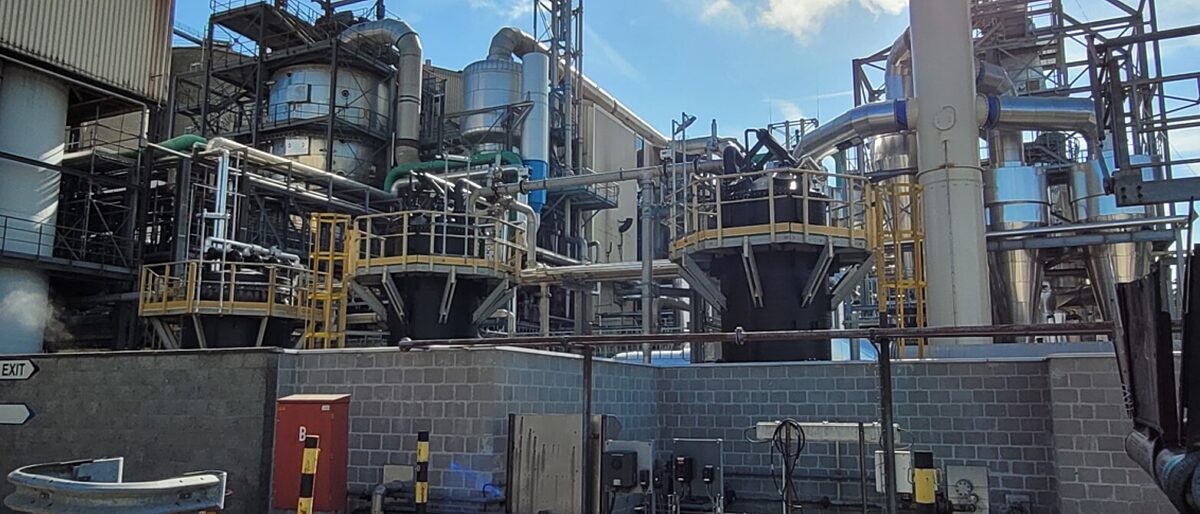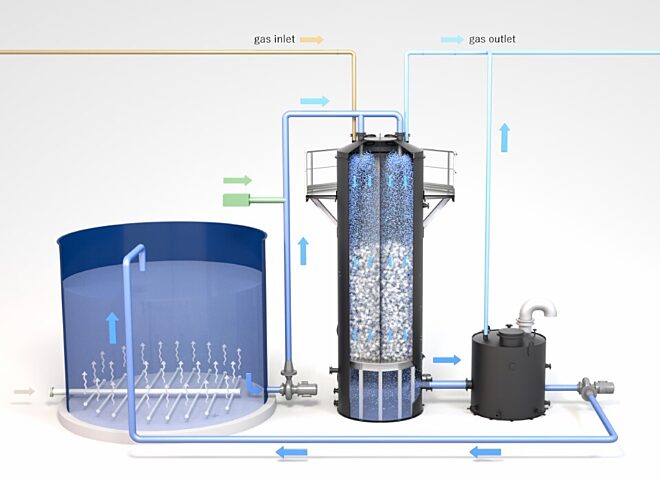H2S Biogas Scrubber - BIOTIM®
Efficient, Flexible, and Cost-effective Biogas Desulfurization from Hydrogen Sulfide

What is a H2S Biogas Scrubber
An H2S biogas scrubber is a system designed to remove hydrogen sulfide (H2S) from biogas. Hydrogen sulfide is a toxic and corrosive gas commonly found in biogas produced through anaerobic digestion. The scrubber uses chemical, biological, or physical processes to capture and neutralize H2S, ensuring the biogas is safe and suitable for energy production and other uses.
Removing H2S improves the biogas quality, protects equipment from corrosion, and reduces harmful emissions, making the biogas more environmentally friendly and efficient for use in various applications.
What is biogas?
Biogas is a renewable energy source produced through the anaerobic digestion of organic materials such as agricultural waste, manure, municipal waste, plant material, sewage, green waste, and food waste. It primarily consists of methane (CH4) and carbon dioxide (CO2), with small amounts of other gases, including hydrogen sulfide (H2S).
What is Hydrogen Sulfide?
Hydrogen sulfide (H2S) is a colourless, flammable gas with a characteristic odour of rotten eggs. It is highly toxic and corrosive, commonly produced by the bacterial breakdown of organic matter in the absence of oxygen, such as during the anaerobic digestion process in wastewater treatment plants. H2S can pose serious health risks, including respiratory issues and even death at high concentrations.
It is also corrosive to metals, which can damage equipment and infrastructure. Therefore, controlling and removing H2S is crucial in various industrial and environmental processes to ensure safety and protect infrastructure.
the BIOTIM®scrubber: How it works
The BIOTIM® scrubber system is ingeniously designed with two synergistic components for streamlined operation:
- The biogas scrubber adeptly strips hydrogen sulfide from both biogas and extraction gases, ensuring their purification.
- The accompanying aerobic wastewater treatment plant or flash aeration tank, which produces and refreshes the scrubbing solution, thereby facilitating the continuous operation of the scrubber.
Acting as the core unit for biogas desulfurization, the scrubber efficiently transfers hydrogen sulfide from the gas to the liquid phase.
Employing a single- or double-stage operation, the BIOTIM® scrubber allows hydrogen sulfide-laden biogas to ascend through a specially designed packing media. This arrangement maximizes the gas-liquid contact area, enhancing the effective transfer of hydrogen sulfide from the biogas into the wash water.
This process not only ensures the thorough removal of hydrogen sulfide but also optimizes the efficiency and effectiveness of the scrubbing action.

Wash Water Regeneration and Hydrogen sulfide removal process
The wash water, sourced from the nearby aerobic wastewater treatment plant, possesses a mildly alkaline quality, making it ideal for dissolving hydrogen sulfide into the water. This process is notably cost-effective.
As the wash water descends through the BIOTIM® scrubber, it progressively accumulates hydrogen sulfide, becoming highly concentrated. This enriched wash water is then collected at the scrubber's base and redirected to the aerobic wastewater treatment plant for rejuvenation.
At the aerobic wastewater treatment facility, the wash water undergoes regeneration through the aerobic oxidation of hydrogen sulfide into sulfate. This transformation is efficiently carried out by a diverse range of naturally occurring bacterial families present in the wastewater, facilitating a swift activation and a stable, high-performing operation.
The chemical reaction involved in this process is
H2S + 2 x O2 = 2H+ + SO42-
The equation illustrates the conversion of hydrogen sulfide to sulfate.
Employing a single-stage process, the BIOTIM® scrubber is capable of eliminating up to 90% of hydrogen sulfide from both biogas and extraction gases, showcasing its efficacy and environmental benefit.

Advantages and benefits of a biogas scrubber
The BIOTIM® scrubber stands as a leading solution in sustainable biogas and extraction gas treatment, characterized by its:
- Flexibility: The BIOTIM® scrubber demonstrates exceptional adaptability to fluctuating feedstock conditions. Its sulfur loading capacity can be dynamically adjusted from 30% to 100% within minutes, ensuring efficient operation under varying demands.
- Zero Chemical Consumption: Thanks to the utilization of mixed liquor and the absence of a need for external nutrients, the system operates without the addition of chemical substances, enhancing its eco-friendly profile.
- Minimal Operational Oversight: The process of hydrogen sulfide absorption is governed by simple parameters such as temperature, pH, and flow rate, thereby eliminating the necessity for intricate control mechanisms or continuous supervision.
- Continuous Regeneration through Bio Flash Aeration: Leveraging regenerated biomass from either the aerobic wastewater treatment facility or flash aeration processes, the BIOTIM® scrubber circumvents the expense associated with caustic soda, further reducing operational costs.
- Efficient Oxidation of Hydrogen Sulfide to Sulphate: The conversion of hydrogen sulfide into sulphate is efficiently carried out by a diverse array of bacterial families, ensuring a rapid start-up and steadfast system performance.
- Unmatched System Availability: Owing to its intelligently simple design, the BIOTIM® scrubber requires minimal maintenance and scarcely any follow-up, resulting in unparalleled availability. This reliability eliminates the need to draw gas from the grid during routine maintenance and avoids the generation of CO2 emissions that would otherwise need to be compensated for, underscoring its environmental benefits.
Ecofrost - Biogas Desulphurization with BIOTIM® Scrubbers
Our client, Ecofrost SA-NV, a leading processor of potato products, as they aim to double their overall production in the next six months. The wastewater treatment facility at their Péruwelz production site includes a large UASB reactor, which reduces organic pollution and produces biogas for power and heat generation.
Waterleau has partnered with Ecofrost to handle the biogas pretreatment. In Waterleau’s three BIOTIM® scrubbers, H2S is removed from the biogas by transferring it to the washing liquid, sourced directly from the aerobic reactor. The H2S levels in the scrubber’s gas outlet are kept below 100 ppm, making the biogas safe for use in the combined heat and power unit.
With 98% H2S removal, no chemical usage, easy maintenance, and low operational costs, Waterleau’s BIOTIM® biogas scrubber unit is delivering outstanding performance.
Check out our client’s testimonial and hear from Jeannot Hoflack, Ecofrost’s Operations Director, about the unit’s impressive performance.
A smart design, based on experiences and know-how
Biogas frequently contains contaminants such as hydrogen sulfide, necessitating removal for its clean and efficient use. Additionally, gases extracted in the process must be purified prior to atmospheric discharge.
Waterleau, with its extensive experience in operating municipal and industrial wastewater treatment plants, including biogas desulfurization systems from a variety of technology providers, has developed a profound expertise in evaluating the strengths and weaknesses of both biological and caustic scrubbing technologies. Leveraging this expertise, Waterleau has engineered its BIOTIM® Scrubber, a design epitomizing simplicity, adaptability, and operational cost efficiency.
Simplicity & best availability
This system's use of freely available, mildly alkaline washing media eliminates the need for harsh chemicals. Its operational simplicity is a key benefit; it demands no specialized skills for ongoing operation, minimal monitoring, and negligible management of critical processes. The BIOTIM® scrubber operates autonomously, demands little maintenance, and excels in operational uptime compared to alternative systems.
It ensures that no valuable biogas is wasted through flaring, nor are there CO2 emissions from operational losses needing compensation. Today, the BIOTIM® scrubber represents the most environmentally friendly biogas purification technology available.
Flexibility
The BIOTIM® system, a biological scrubber, utilizes scrubbing liquid sourced either from the wastewater treatment process itself or a Flash Aeration tank. Its utilization of a broad spectrum of bacteria ensures exceptional adaptability to changes in sulfur concentrations and flow rates, making it an exceptionally reliable solution for facilities experiencing variable production cycles.
Removal efficiency of up to 99%
The enhanced two-stage BIOTIM® scrubber system offers superior hydrogen sulfide extraction capabilities. This advanced model features a dual-chamber tower, each chamber functioning in tandem to maximize purification. Initially, the first compartment succeeds in eliminating up to 90% of hydrogen sulfide. The subsequent stage mirrors the first in volume and residence time, employing counterflow liquid-gas interaction to absorb the residual hydrogen sulfide, thus achieving an impressive removal efficiency of up to 99%.
To accommodate the processing of larger gas volumes, multiple BIOTIM® scrubbers can be deployed in parallel, ensuring scalable and efficient treatment.
For scenarios characterized by exceptionally high hydrogen sulfide levels, the 4-stage BIOTIM® biogas scrubber is recommended. This configuration, comprising four distinct compartments, is designed to optimize gas flow through each stage, securing the highest feasible purification performance with up to 99% of hydrogen sulfide removal.
This multistage approach not only enhances the overall efficiency but also ensures adaptability to varying gas stream conditions, making it a robust solution for comprehensive gas treatment.
Contact us
Are you in search of a durable, adaptable, and user-friendly solution for biogas and extraction gas treatment?
Do you require a system that can quickly adjust to sulfur load variations? Are you aiming for optimal operational uptime with minimal expenses?
Reach out to us today. We are eager to share our expertise in biogas purification and introduce you to our BIOTIM® scrubber technology.
FAQ
Are there more types of wet scrubbers?
Yes, there are several types of wet scrubbers used to remove pollutants from gas streams by bringing them into contact with a scrubbing liquid. Common types include:
- Venturi Scrubbers: Utilize a high-velocity gas stream to atomize the scrubbing liquid and enhance pollutant removal.
- Packed Bed Scrubbers: Use a packed column where the gas flows through a bed of packing material that provides a large surface area for gas-liquid contact.
- Spray Tower Scrubbers: Rely on spraying the scrubbing liquid into the gas stream in a tower, providing efficient contact between the liquid and the gas.
- Cyclonic Scrubbers: Combine cyclonic action with liquid scrubbing to remove particulates and gases.
What creates biogas?
Biogas is created through the anaerobic digestion of organic materials. This process involves microorganisms breaking down biodegradable material in the absence of oxygen. Common sources include:
- Agricultural waste
- Manure
- Municipal solid waste
- Sewage
- Green waste
- Food waste
Why is hydrogen sulfide removal important?
Hydrogen sulfide (H2S) removal is important because:
- Safety: H2S is highly toxic and can pose serious health risks to humans, including respiratory problems and even death at high concentrations.
- Corrosion: H2S is corrosive to metals, which can damage equipment and infrastructure, leading to increased maintenance costs and potential failures.
- Environmental Impact: Removing H2S reduces harmful emissions, improving the environmental footprint of biogas usage.
- Quality of Biogas: Purified biogas with reduced H2S content is more suitable for use in energy production, as fuel, and for heating purposes.
How can I choose the right biogas scrubber for my facility?
Choosing the right biogas scrubber for your facility involves several considerations:
- Gas Composition: Analyze the composition of your biogas to determine the levels of H2S and other contaminants.
- Flow Rate: Determine the volume of biogas that needs to be processed to ensure the scrubber can handle the required capacity.
- Efficiency: Consider the removal efficiency needed for your specific application, ensuring the scrubber can achieve the desired purity levels.
- Operating Costs: Evaluate the operational costs, including energy consumption, maintenance, and replacement of scrubbing media.
- Technology: Choose between chemical, biological, or physical scrubbing methods based on your facility’s needs and preferences.
- Space and Installation: Consider the available space and ease of installation, as some scrubbers require more space or specific conditions for optimal operation.
- Regulatory Compliance: Ensure the scrubber meets any regulatory requirements for emissions and environmental protection.
Discover our BIOTIM Technologies
Find your local contact
Our expertise is always within reach. Digital communication has cut long distances short, but we advocate the traditional way of sharing insights.
Contact us today. We are looking forward to help you reach your sustainable development goals.




